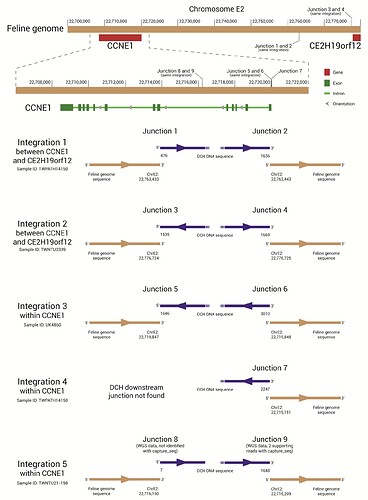Hepatitis B virus (HBV) is the major cause of liver cancer in humans, largely believed to be due to viral DNA integrating into host genes.
Understanding the mechanisms of integrations has been challenging; mainly due the numerous viral forms with identical sequences, as well as the small size of the viral genome (~3,000 base pairs) compared to the host genome (~6 billion base pairs).
To address this, we developed a novel targeted sequencing pipeline that allows detection and identification of viral DNA integrations. We validated the system using immortalized human liver cell lines infected with HBV and found that viral integrations could cause genomic rearrangements, changes that could lead to cancer development.
We then used our pipeline to investigate viral integrations in cats infected with a recently (2018) discovered virus similar to HBV, domestic cat hepatitis B virus (DCHBV), which infects cats worldwide but its role in feline liver cancer is unclear.
We investigated liver tumor samples from cats infected with DCHBV. We discovered viral DNA integrations in 11 out of 16 feline liver cancer samples from DCHBV-positive cats, but none in the DCHBV-negative group. These integrations were especially common near the CCNE1 gene (Figure 1), which regulates cell division and is also a known hotspot in human HBV-related liver cancers.
This is the first evidence that DCHBV integrates into the cat genome and is associated with liver cancer in cats, in a process similar to human HBV infection. Our work positions cats as a valuable model for studying HBV-associated cancers.
Figure 1. DCHBV DNA integrations within CCNE1 . The cat CCNE1 and CE2H19orf12 genes in chromosome E2 are shown in red. CCNE1 exon and introns are represented in dark and light green, respectively, and gene orientation represented with grey arrows. Nine junctions from 5 unique integrations near and within CCNE1 from different samples represented. Junctions 1-2, 3-4, 5-6, and 8-9 represent junctions of the same integration, respectively. The feline genome is shown in brown and the DCHBV DNA sequence is shown in blue.
